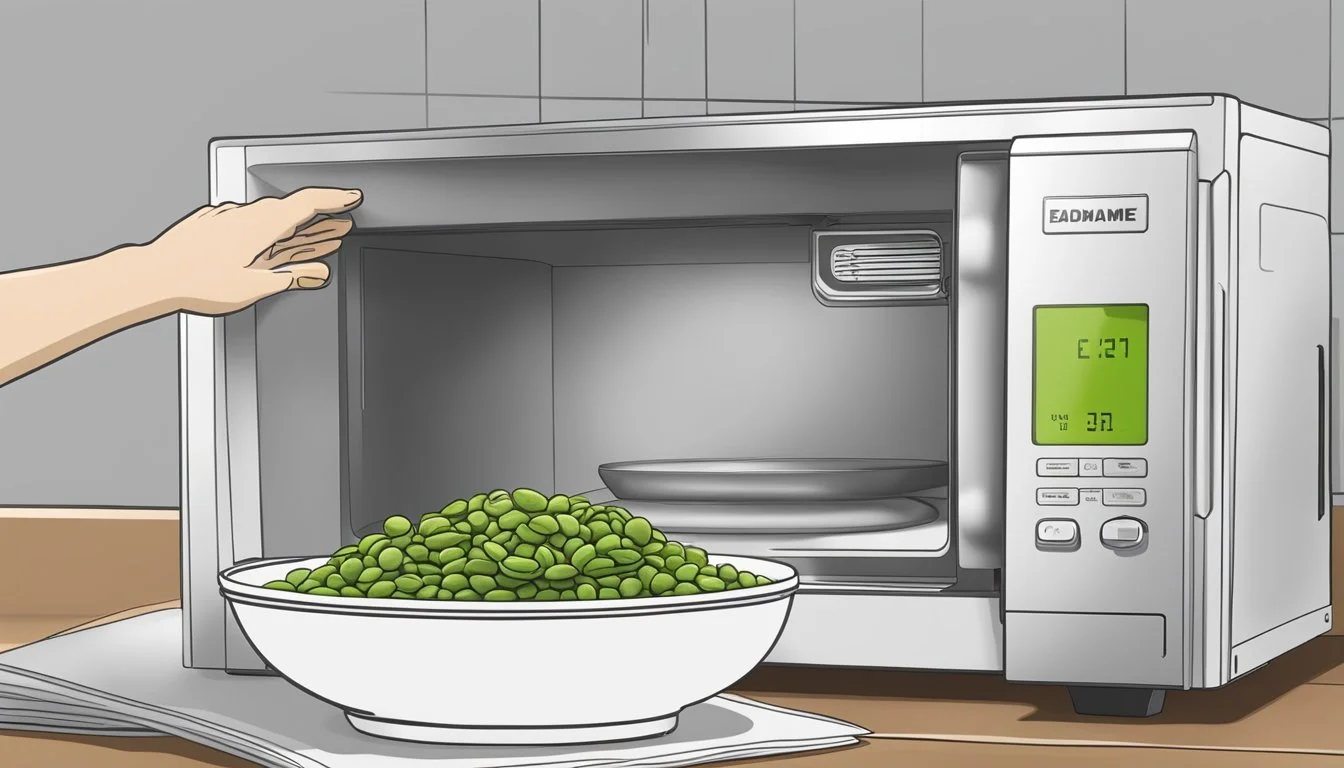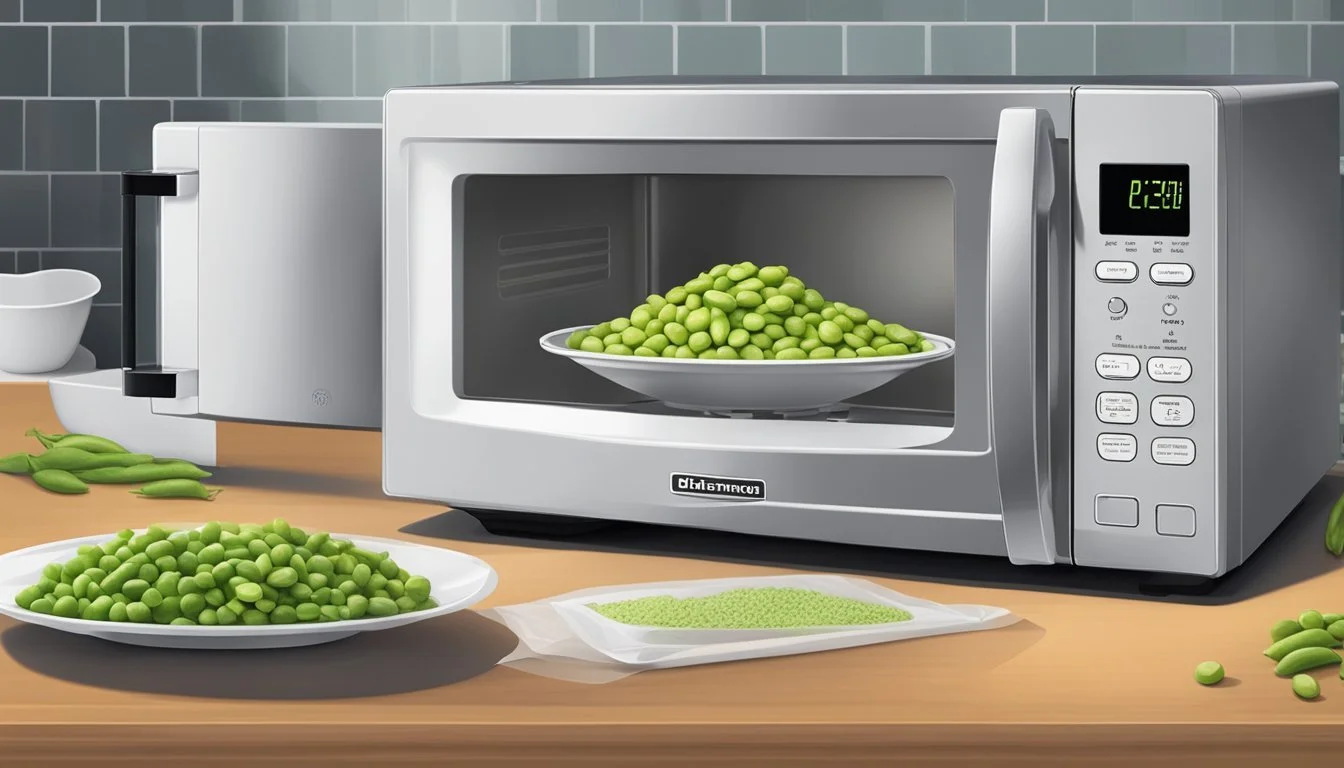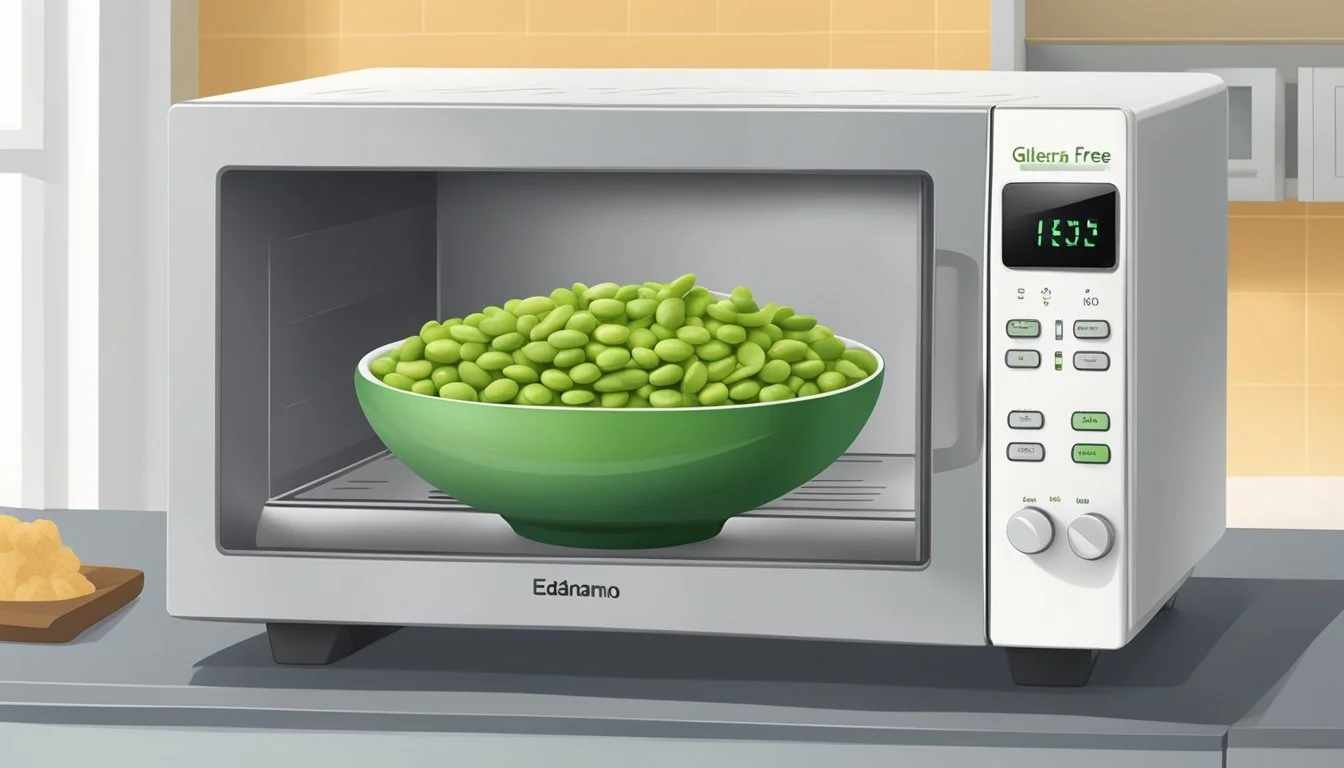How to Reheat Gluten-Free Edamame
Simple and Effective Methods
Edamame, a protein-packed and nutrient-rich snack, has become a favorite among those seeking healthy and gluten-free options. This plant-based delight is both delicious and versatile, making it a staple in many kitchens. When it comes to reheating gluten-free edamame, maintaining its texture and flavor is essential.
To reheat gluten-free edamame effectively, using methods like steaming, microwaving, or even an air fryer can ensure the snack remains tender and flavorful. Steaming edamame for a couple of minutes helps preserve its nutritional value while keeping it moist and tasty. For a quick solution, microwaving can also work well, especially when you're short on time.
Reheating edamame without compromising its health benefits and taste requires a few simple techniques that anyone can master. This guide will explore various methods to enjoy this nutritious snack once again, maintaining its role as a go-to source of plant-based protein.
Understanding Edamame
Edamame, young soybeans in their pods, are enjoyed for their nutritional value and versatility. They are rich in various nutrients and are consumed in different forms.
What Is Edamame
Edamame refers to immature soybeans usually steamed or boiled and often served as an appetizer in Japanese cuisine. The term "edamame" translates to "beans on branches." These beans are harvested at a younger stage than traditional soybeans, resulting in a sweeter and softer texture. Typically found shelled or in the pod, edamame is often lightly salted for added flavor. Its popularity stretches globally due to its health benefits and simplicity in preparation.
Nutritional Profile
Edamame is a nutrient-rich food. It is high in protein, making it an excellent plant-based protein source for vegetarians and vegans. In addition to protein, it contains significant amounts of fiber and fat.
Here is a brief nutritional breakdown per 100 grams:
Protein: 11 grams
Fiber: 5 grams
Fat: 4 grams
Edamame is also rich in essential vitamins and minerals such as iron, calcium, folate, and potassium. With high levels of vitamin K and antioxidants, it supports various bodily functions. The low carbohydrate content and minimal sodium make it a healthy choice for many diets.
Varieties and Selection
Edamame is available in several forms. Consumers can purchase it fresh, frozen, shelled, or in the pod. Fresh edamame has a short shelf life and should be used promptly, while frozen varieties are more convenient for long-term storage.
When selecting edamame, look for vibrant green pods that are firm to the touch. Avoid any that appear yellowed or have spots. Fresh edamame should be stored in the refrigerator and consumed within a few days or kept frozen until ready to use.
This versatile legume can be steamed, boiled, or even roasted, enhancing its natural, nutty flavor.
Preparation Basics
Before reheating gluten-free edamame, it is crucial to ensure they are properly washed and sorted. Additionally, knowing the appropriate prep time can impact the quality and flavor.
Washing and Sorting
Washing the edamame is an essential first step. Use cold water to rinse both shelled and unshelled edamame thoroughly to remove any dirt or residues. If using frozen edamame, allow them to thaw slightly for easier sorting.
Check for any discolored or damaged beans and remove them. For a quicker rinse, consider using a colander. Drain the edamame well to ensure there’s no excess water, which can affect the reheating process.
This step ensures the edamame is clean and ready for further preparation.
Prep Time for Edamame
The prep time for edamame varies depending on whether it is fresh or frozen. Fresh edamame may require a bit more time for washing and sorting. On the other hand, frozen edamame is usually prewashed and only needs a quick rinse.
If you’re planning to steam or boil the edamame, account for additional time to bring the water to a boil. For microwaving, the total prep time can be shorter since you can directly cook the edamame after washing.
Typically, the entire preparation should not exceed 10 minutes, ensuring the edamame stays flavorful and nutritious.
Cooking Techniques
When reheating gluten-free edamame, it's essential to choose the right method to retain its taste and texture. This section outlines three different techniques: boiling, steaming, and using an air fryer. Each method offers unique benefits and suits specific preferences.
Boiling Edamame
Boiling edamame is a straightforward method. Begin by filling a pot with enough water to cover the edamame. Bring the water to a rolling boil. Once boiling, add the shelled or unshelled edamame to the pot.
Boil the edamame for 3-5 minutes if reheating, or 5-7 minutes if cooking from raw. After boiling, remove the pot from the heat and drain the water.
This method ensures the edamame is evenly heated and retains its nutritional value. Season with salt or your favorite spices before serving.
Steaming Edamame
Steaming is a gentle way to reheat edamame. To steam, place the edamame in a steamer basket over a pot of boiling water. Ensure the water does not touch the edamame directly.
Cover the pot and steam for 3-5 minutes for reheated edamame. If cooking from fresh, extend the steaming time to 5-7 minutes. This method preserves the delicate flavor and texture.
After steaming, remove the edamame from the basket and season as desired. This approach keeps the edamame's vibrant green color intact and avoids overcooking.
Using an Air Fryer
The air fryer provides a quick and easy option for reheating edamame. Preheat the air fryer to 375°F (190°C). Place the edamame in the air fryer basket in a single layer to ensure even cooking.
Cook the edamame for 2-4 minutes if reheating, or 6-8 minutes if cooking from raw. Shake the basket halfway through the cooking time to ensure uniform heating.
This method adds a slight crispiness to the edamame, enhancing its texture. After air frying, sprinkle with seasoning and serve immediately.
Seasoning and Flavoring
Seasoning edamame adds an extra layer of taste, elevating this already nutritious snack. From traditional approaches to innovative twists, the right seasoning can make all the difference.
Classic Seasonings
Classic seasonings are simple yet effective in enhancing the natural flavors of edamame.
Salt and Pepper: A quintessential combination that brings out the edamame's natural flavor without overpowering it. Use sea salt and freshly ground black pepper for the best results.
Soy Sauce or Tamari: For a classic Japanese touch, drizzle soy sauce or tamari—a gluten-free alternative—to add a burst of umami. Tamari is especially great for those maintaining a gluten-free diet.
Olive Oil and Garlic: Lightly coat the edamame with extra virgin olive oil and sprinkle with minced garlic. This duo adds richness and a delightful aroma, transforming the edamame into a more savory treat.
Sesame Seeds: A touch of toasted sesame seeds can add a slight nuttiness and a bit of crunch. This works well with other classic seasonings like soy sauce or tamari, creating a balanced flavor profile.
Innovative Twists
For a more adventurous palate, innovative seasonings offer unique and delightful combinations.
Red Pepper Flakes: Adding a pinch of red pepper flakes gives the edamame a spicy kick. This can be combined with a drizzle of olive oil for a spicy and savory blend.
Asian-Inspired Blends: Mix soy sauce or tamari with a bit of brown sugar and ginger for a sweet and savory twist. Add some chopped scallions for extra freshness.
Italian Herbs: Incorporate oregano, basil, and thyme for a Mediterranean flair. Sprinkle parmesan cheese for added flavor depth.
Citrus Zest: A bit of lemon or lime zest can brighten the flavors, offering a refreshing twist. Combine this with sea salt and black pepper for a simple yet sophisticated option.
Through both classic and innovative seasonings, edamame can be tailored to fit a wide variety of tastes.
Serving and Presentation
Gluten-free edamame can be presented effectively as both a side dish and a main course. Each approach brings out different aspects of this versatile and nutritious food.
As a Side Dish
Edamame can be a simple and elegant side dish. It's ideal for pairing with Asian cuisine like sushi, ramen, or teriyaki dishes. A sprinkle of sea salt or sesame seeds enhances the flavor without compromising the gluten-free nature.
Consider serving in small bowls to make it easy for guests to share. Adding a few slices of fresh lemon or lime can elevate the presentation and bring a fresh, tangy accent. Colorful garnishes like red chili flakes or finely chopped green onions can make the dish pop for an Instagram-worthy pic.
Serving the edamame warm ensures that it maintains its tender texture. To keep the edamame hot, consider using insulated serving dishes. This not only helps with the temperature but also keeps the edamame looking vibrant and appetizing.
As a Main Course
When presented as a main course, edamame can be the star of the meal. It can be incorporated into salads, rice bowls, or even stir-fries. Combine the edamame with other colorful vegetables like bell peppers, carrots, and snap peas to create a visually appealing and nutritious plate.
In a rice bowl, edamame pairs well with quinoa, brown rice, or cauliflower rice for a gluten-free base. Topping with a soy-sesame dressing or gluten-free soy sauce adds layers of flavor.
For a more substantial meal, consider adding lean protein such as grilled chicken or tofu. When serving, arrange the elements neatly in a large bowl or platter. This kind of presentation is not only practical but also visually satisfying, making every meal feel like a special occasion.
Proper Storage
Proper storage of gluten-free edamame is crucial to maintain freshness and nutritional quality. Whether keeping it for a short duration or freezing it for long-term use, follow these best practices.
Short-Term Storage
For short-term storage, edamame should be kept in the refrigerator. Place fresh or cooked edamame in an airtight container or resealable plastic bag. Ensure that any moisture on the surface has been removed to prevent sogginess.
Shelled edamame can last up to 3 days in the fridge. It's advisable to consume it within this period for the best flavor and texture. If storing unshelled edamame, it can last slightly longer but still aim to use it within a week. Keep the edamame in the crisper drawer to maintain optimal temperature and humidity.
Long-Term Freezing
For long-term storage, freezing is the most effective method. Start by blanching fresh edamame in boiling water for about 3-5 minutes, then transfer them immediately to ice-cold water to halt the cooking process. This step preserves color and texture.
Once cooled, dry the edamame thoroughly and spread them on a baking sheet to freeze for a few hours. After they are frozen, transfer them to an airtight container or a vacuum-sealed bag, removing as much air as possible. Properly stored, frozen edamame can maintain its quality for up to 12 months.
When ready to use, simply thaw the frozen edamame in the refrigerator or reheat directly from frozen using your preferred method.
Reheating Edamame
Reheating edamame can be done using methods like the microwave or stovetop. Each way ensures the edamame retains its texture and flavor, making leftovers just as enjoyable.
Using Microwave
To reheat edamame in the microwave, start by placing the edamame (shelled or unshelled) in a microwave-safe bowl. Add one tablespoon of water for a full bowl, which helps to keep the edamame moist.
Cover the bowl with a wet paper towel or pierced plastic wrap to create steam. Microwave the edamame on high for 30-60 seconds if thawed, or 1-2 minutes if frozen. Let the edamame rest for 30 seconds after heating.
Once reheated, season to taste with salt or your preferred spices. The microwave method is quick, making it ideal for a fast snack or addition to meals.
Stovetop Method
Using the stovetop method, add a tablespoon of salt to a gallon of water for seasoning. Bring the water to a rapid boil in a large pot.
Place the edamame in a cooking basket or strainer, and immerse it in the boiling water. Boil for 2-3 minutes if the edamame is thawed or 4-5 minutes if frozen.
After boiling, immediately transfer the edamame to a bowl of ice water to stop the cooking process and retain its color and texture.
This method ensures evenly warmed edamame with a delightful, slightly firm bite.
Pairing with Other Foods
Edamame is a versatile and nutritious snack that pairs well with a variety of dishes. Its high protein content makes it suitable for vegan and vegetarian diets, seamlessly fitting into salads and main dishes like fried rice and ramen.
Edamame in Salads
Edamame can be a delicious and protein-packed addition to salads. Green salads gain color and texture from these bright beans. They pair well with mixed greens and heartier bases like quinoa or farro. Including edamame can boost the protein content significantly, making the salad more filling and nutritious.
Edamame also blends well with other toppings. Cherry tomatoes, cucumbers, and shredded carrots are excellent companions. A light vinaigrette or Asian-inspired dressings, like sesame-ginger, complement the soybeans' flavor. For a vegan or vegetarian option, pair with tofu or tempeh cubes, enhancing the meal's overall protein intake.
Incorporation in Main Dishes
Edamame can be integrated into various main dishes. In fried rice, they add both texture and nutritional value, balancing the dish with a green component. Similarly, in soups like ramen, edamame offers a protein boost, marrying well with the broth and other vegetables.
When adding to stir-fries, the beans maintain their texture and contribute to a colorful mix of ingredients such as bell peppers, onions, and broccoli. Edamame also works well in grain bowls, combined with brown rice, barley, or quinoa, and topped with a flavorful sauce.
Edamame's versatility ensures it can enhance many dishes while supporting dietary needs like those of vegans and vegetarians.
Health Considerations
When reheating gluten-free edamame, it's important to be mindful of dietary concerns and the possible health benefits these nutritious young soybeans provide.
Dietary Concerns
Edamame is naturally gluten-free and low in calories, making it an excellent choice for those with gluten sensitivities or looking to maintain a healthy diet. Rich in dietary fiber, it helps in digestion and can keep one feeling full longer. Nutrition facts highlight that a typical serving of edamame contains essential nutrients such as protein, iron, calcium, and vitamins A and C.
Edamame offers considerable daily values of these nutrients. Because it’s an immature soybean, it retains more of these nutritional benefits compared to mature soybeans. This makes it a valuable addition to any nutrition information profile for those monitoring their micronutrient intake or following a balanced diet.
Possible Benefits
Reheated edamame retains many of its health benefits, even after cooking. Edamame contains compounds that may aid in reducing the risk of certain chronic diseases, including cancer. It is considered a superfood because of its high protein and low-fat content along with its important vitamins and minerals.
Regular consumption of edamame can provide health benefits such as reducing cholesterol levels, aiding weight management, and improving bone health. These young soybeans, rich in antioxidants and anti-inflammatory properties, can also support overall well-being when included as a part of a balanced diet.
By understanding these considerations, one can maximize the potential health benefits edamame offers while ensuring it fits comfortably within dietary requirements.
Final Thoughts
Reheating gluten-free edamame can be done efficiently while maintaining their tender texture and savory flavor.
For a quick option, the microwave method takes a total time of just a few minutes. This method is great for retaining the tenderness of shelled or unshelled edamame.
For those who prefer a crispy texture, using an air fryer is a popular choice. Preheating the air fryer to 375°F (190°C) and then air frying the edamame for about 8-10 minutes ensures an evenly heated snack.
Boiling and steaming offer another way to reheat leftover edamame while keeping it tender and flavorful. Simply add the edamame to boiling water, followed by an ice bath to retain its color and texture.
Roasting edamame can also bring out a delicious roasted flavor, making it an enticing option for those who enjoy more complex taste profiles.
It is essential to avoid overcooking when reheating as it can make the edamame lose its freshness and vibrant color.
By carefully choosing the reheating method, it's possible to enjoy reheated edamame that tastes as good as when it was freshly prepared.










